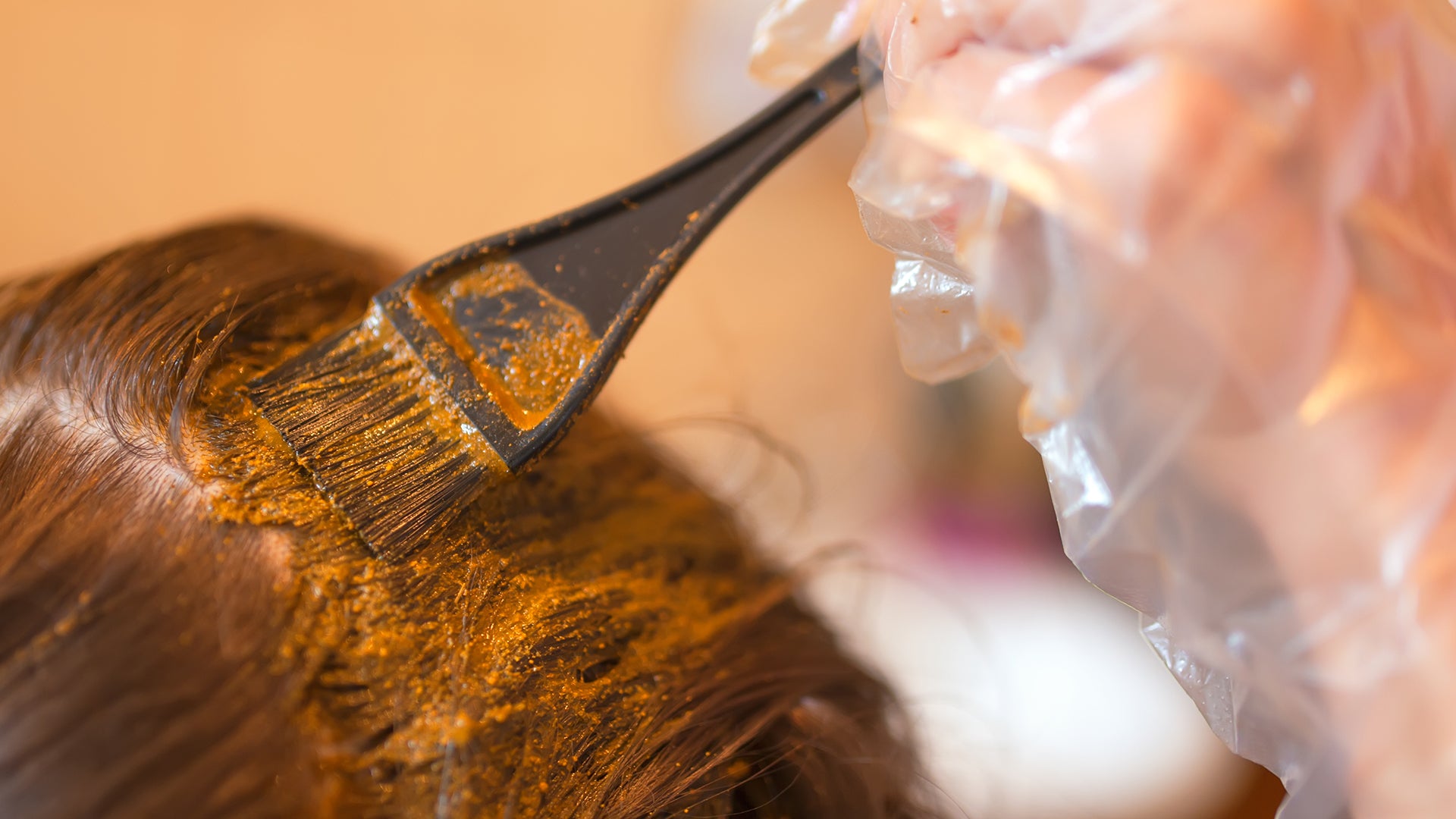
We’ve all experienced a bad hair day, but when the oiliness gets out of hand it can become a bit of a headache – think dandruff, wet-looking hair, and acne – but can you dye greasy hair?
Well, the answer isn’t as straightforward as you might think, but don’t let that stop you from achieving the hair colour of your dreams.
We’re going to bust some myths about greasy hair, share some tips on dying it and sharing some surprising benefits of henna for oily hair. But first, what causes oily hair?
The down-low on greasy hair: what causes it?
Our hair naturally produces a substance called sebum, the oils that work to keep the hair strong and healthy day to day. Usually, this means coating the hair to protect it from the outside and keeping moisture at optimal levels.
Over time sebum can build up and sometimes our scalps produce an excess of it – but why is that? There are several factors that may exacerbate the production of oil. Here are just a few.
Washing your hair too often or too little
While there’s much debate on how often you should wash your hair, the general consensus is that it depends on hair texture. Straighter and thinner hair will collect grease more quickly than curls, and textured hair needs to be washed the least.
Of course, everyone’s hair is unique, so if these tips don’t work for you try out different routines until you find the one that works best for you.
Your hair doesn’t like the products you put in it
Excessive oiliness can often be an indicator that your hair doesn’t gel well with the hair products you’re currently using. Greasy hair paired with itchiness might mean that you’re allergic to one of the components such as ammonia or parabens. If you think this might be the case, switching to hypoallergenic hair care is a step in the right direction.
Using too much product
If you’ve reached for the conditioner as a quick fix to a dry or sensitive scalp, make sure to keep the application away from your scalp, sticking to the tips and mid-lengths – and the same goes with natural oils such as coconut oil.
For fans of hair masks, try not to exceed three treatments per week as this can also lead to excess oil. Remember: sometimes less is more.
Hormonal changes
Hormonal changes have a lot to answer for and one of those things is the oiliness of your hair. Whether you’re going through a big life change like pregnancy, puberty, menopause and HRT, or you’re experiencing day-to-day changes from the menstrual cycle, the fluctuating level of hormones in your body can have a knock-on effect on sebum production.
As always, if this is having an adverse effect on your life make sure to visit your GP.
Sensitive scalp conditions
There are numerous sensitive scalp conditions that might lead to greasy hair. From dandruff to eczema and psoriasis, these skin conditions may cause the glands to produce extra sebum to combat the oiliness. In this instance, it’s advised that you see a specialist so you can get to the root of the problem.

Answering your FAQs: can you dye greasy hair?
So can you dye greasy hair? The answer generally relies on the level of oiliness. Extremely greasy hair works against the even distribution of the dye pigment, leading to an uneven look.
This being said hair experts agree that some grease is beneficial to the colouring process. With henna hair dyes, for example, the product takes better on dirtier hair that is a little oily.
How oily is too oily?
As we said, a little oiliness can help the colour take to your hair. If you’re opting for a traditional box dye, the higher levels of peroxide and ammonia will break through the oil and dirt on your hair. The same is true of henna.
However, make sure not too have so much grease in your hair as to make the dye process more difficult. If your locks are too oily after 4 or more days without cleaning or you have oiled your hair recently, consider washing and leaving your dye job for the next day or so.
What are the optimal conditions for dying your hair?
If you want your hair dye experience to be as smooth as possible, we recommend dying it neither freshly washed or excessively dirty, leaving only a tiny amount of grease in your hair. It turns out a little sebum can work wonders.

5 Post-hair colour care tips
1. Wait a day or two before washing your hair
You might find conflicting information when looking for answers to this question, but most experts suggest waiting between 24 and 48 hours before washing your hair after your colouring session. This allows some time for the colour to set in and the hair cuticle to close and retain your new, vibrant shade.
2. Add a henna shampoo or conditioner to your routine
Henna is great for your hair and is a safer, healthier alternative to traditional products that are laced with chemicals such as sulphates, benzene and parabens. Wait for a few days after the colouring session for stunning results.
3. Infuse with essential oils
Whether you’ve gone for a traditional box dye or have landed on the healthier option (henna), it’s a good idea to take steps to avoid your hair becoming dry and brittle. This is far less likely to happen if you coloured your hair using a henna dye, however, it’s better to be safe than sorry.
If your hair is particularly oily naturally, you might want to skip this step or make essential oils a monthly treat.
4. Mask up those tresses
Similar to the oils and conditioner, hair masks can offer added silkiness as they restore, repair and hydrate your hair from root to tip.
5. Make the heatless pledge
One final step you can take to ensure your hair remains gorgeous after its colour treatment is avoiding heat styling methods such as blow drying and straightening. This will make the colour fade faster and, in the long run, can damage your beautiful hair.
The benefits of henna for oily hair
You might not be aware of this, but henna for oily hair is one of the beauty industry’s best-kept secrets. Used practically for millennia, this ancient treatment is a completely natural way to strip your hair of the bad stuff and inject all of the good. Let’s take a deeper look.
Rebalances scalp oil production
Cast your mind back to the causes of greasy hair: we mentioned that using the wrong products can aggravate the problem. Fortunately, henna hair dye is hypoallergenic and 100% natural.
One of its merits is that it naturally regulates the pH of your hair, penetrating the hair follicles and scalp for a deep, deep cleanse that help calm those hyperactive sebaceous glands.
Deep conditions your hair and soothes your scalp
Among henna’s countless benefits, this one is particularly handy for sufferers of oily hair. When you have a dry scalp, often your oil glands will work overtime, but henna can counteract this by dealing with the dryness.
Henna products leave a sealing layer on the hair cuticle so the strands can absorb and retain moisture, and this is all whilst nourishing and soothing your scalp – so two benefits in one!
Protects from dandruff
Dandruff is often caused by dry, flaking skin or the overproduction of oil. The beauty of henna is that it possesses anti-microbial and anti-inflammatory properties. Apply it to your locks and watch it restore the microbial balance, removing excess grease and dirt from your scalp.
To sum up
We hoped we’ve cleared up this murky topic and dispelled a few myths. So, can you dye greasy hair with henna and conventional dye products? Absolutely! As long as you have washed your hair a day or two before application and your lovely tresses aren’t excessively oily, you’ll be good to go.
Make sure not to forget the aftercare and switch to henna shampoo to rebalance your hair’s pH. This will help you reduce any unwanted oiliness and keep your head happy and healthy.
Take the plunge with your first henna colour change!
Now, go ahead and discover the magic of henna. Whether you’re in it for the abundance of colour possibilities or to take back control with oily or greasy hair, henna hair products are revolutionary – we promise you.

